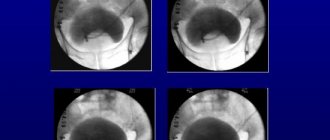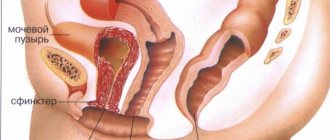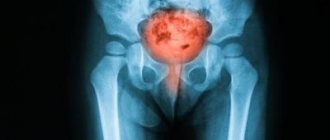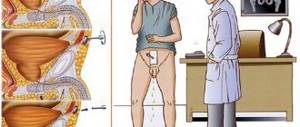Tuberculosis of the bladder can have different symptoms and causes; they can vary depending on the stage of development of the disease and which human organs are affected in parallel. Tuberculosis of the genitourinary system is often accompanied by kidney damage and various complications. Treatment of the disease should be immediate.
Pathogenesis of kidney tuberculosis
Genitourinary tuberculosis is a late manifestation of pulmonary tuberculosis infection, which occurs as a result of reactivation of old, so-called dormant tuberculosis lesions by pathogenic complexes of Mycobacterium tuberculosis.
Numerous studies have proven that the primary tuberculosis focus in the kidney appears in the area of the vascular glomeruli due to hematogenous (less often lymphogenous) spread of infection from the lungs. Thus, during a primary pulmonary infection, alveolar macrophages located inside the pulmonary alveoli capture one or more Mycobacterium tuberculosis - they are extremely resistant to destruction and continue to multiply inside the macrophages.
From the lungs, tuberculosis infection spreads throughout the body through the lymph and bloodstream and enters the glomerular apparatus of both kidneys, located in the cortex, where microscopic tuberculosis foci are formed.
If the body's immune forces are in good condition, tuberculosis lesions in the kidney can resolve on their own, partially or completely heal, and also become sclerotic. At the same time, the surviving tuberculous mycobacteria remain in the kidneys and remain in a passive state for a long time - subclinical renal tuberculosis occurs.
The disease proceeds very slowly, but as it progresses it leads to extensive necrosis (death) of the renal papillae, the formation of cavities (cavities with the formation of an abscess) and complete destruction of the organ.
The progression of the disease begins with a number of unfavorable factors: first the entire kidney is affected, then the ureter and bladder. Isolated tuberculosis of the ureter or bladder without kidney damage usually does not occur.
In case of a disorder of hemo- and urodynamics of the kidneys, as well as in the case of certain disorders of the immune system, the infectious process spreads from the cortex to the medulla, where inflammation develops in the renal papillae (the mouths of the urinary tubules that open into the renal calyx) - tuberculous papillitis. Ulcerations occur in the area of the renal papillae, which lead to short-term total profuse hematuria in 10-15% of patients.
In the early stages, tuberculous papillitis may be asymptomatic. In general, this disease is quite severe; if several renal papillae are affected by the infectious process, the patient’s general condition worsens - fever, malaise, weakness, and lower back pain occur. Subsequently, the inflammation becomes destructive and covers the entire thickness of the kidney pyramids with caseous decay and the formation of caverns (cavities), which can be either isolated or communicating with the collecting system. The formation of cavities in the kidneys in 20-25% is accompanied by pain, which is usually localized in the lumbar region, similar to renal colic. Decay cavities can clear and turn into smooth-walled cysts.
During the healing of cavities, calcification (deposition of calcium salts) of caseous foci occurs, but this does not mean that they have cleared, since viable mycobacteria often remain deep in the petrification.
Symptoms of bladder tuberculosis
Initially, when an organ is damaged by mycobacteria, characteristic signs do not appear, and nothing bothers the patient. The clinical picture begins with loss of strength. At a time when the body is unable to cope with actively multiplying bacteria, the patient feels unwell, loses weight, eats and sleeps poorly. Excessive sweating and insomnia may occur at night. Fatigue gradually accumulates, and the patient is unable to cope with the same amount of work. However, even at this stage, people often do not go to the doctor, as they blame everything on other everyday problems.
Over time, a new symptom of the disease develops - increased urination. The amount of urination per day can reach up to 20 times. The act is accompanied first by discomfort in the lower abdomen, and then by pain and cramping. Some categories of people experience urinary incontinence.
As the disease progresses, low-grade body temperature, chills, and migraines appear, that is, typical signs of intoxication. If the kidneys are also involved, the pain spreads to the lower back.
The prognosis is poor if there is pus or blood in the urine. This indicates damage to the glomeruli in the kidneys, disruption of tissue structure and extensive necrosis. As the wall of the organ thins, the risk of peritonitis—inflammation of the abdominal cavity due to the rupture of the bladder and leakage of its contents—increases.
In rare cases, inflammation of the genital organs may occur: testicles, ovaries, prostate, uterus. This process disrupts reproductive function and leads to infertility.
Since tuberculosis of the bladder begins with damage to the lungs, it is worth paying attention to the accompanying clinical picture in the form of:
- cough with little sputum;
- hemoptysis;
- pallor of the skin, its moisture;
- increased heart rate;
- blood pressure surges;
- pain in the upper body.
Externally, there may be asymmetry of the chest.
Treatment
At the initial stages of the disease, drug treatment is prescribed. The duration of the course of taking the drugs ranges from six months to several years.
The following medications help stop the spread of Koch's bacillus and reduce its activity:
- Streptomycin;
- Ethambutol;
- Rifampicin;
- Kanamycin.
At the same time, vitamin complexes, angioprotectors and non-steroidal drugs are prescribed. The dosage is determined by the attending physician and depends on the form of the disease, the degree of kidney damage and the individual characteristics of the patient’s body.
If pathology is detected in an advanced state, the choice is made in favor of surgical intervention. Depending on the degree of damage to the organ, its sanitation (cavernotomy), partial resection (cavernectomy) or complete removal (nephrectomy) is carried out. Based on the current situation, the operation is performed open or closed.
When using the laparoscopic method, the surgeon performs manipulations remotely using a device equipped with a video camera. Thanks to this approach, the risk of secondary infection is reduced and the rehabilitation period is reduced.
Methods of therapy
Tuberculosis of the genitourinary system requires long-term treatment in specialized dispensaries. On average, the duration of treatment ranges from a year to 2-3 years.
But timely and competent therapy will help achieve stable remission and significantly improve the quality of life.
The doctor individually chooses a treatment regimen, taking into account the stage of the disease. As a rule, treatment includes taking antibiotics in combination with anti-tuberculosis drugs. The following drugs have proven themselves to be effective:
- Pyrazinamide;
- Rifampicin;
- Isoniazid;
- Ethambutol;
- Prothionamide.
For effectiveness, they are often combined with fluoroquinolones (for example, Ofloxacin).
To monitor the dynamics of the disease, the patient regularly submits urine for examination. Usually, in the early stages, drug therapy is sufficient for successful treatment.
If tuberculosis of the genitourinary system is advanced and has led to pathological changes in organs, the doctor prescribes surgery. The main indications for surgical intervention are:
- ineffectiveness of conservative treatment;
- reduction in bladder size;
- progressive kidney dysfunction;
- strictures of the ureter, spermatic cord, pyelocaliceal part of the kidney.
During the operation, the entire kidney or part of it is removed with excision of fibrous-cavernous formations. If tuberculosis of the bladder provokes the development of microcystitis, then surgery is performed to increase the size of the bladder. If the ureter is damaged, resection followed by plasty is performed.
The prognosis for a timely operation and a completed course of postoperative treatment is favorable. It is possible to achieve stable remission and reduce the severity of symptoms. With bilateral damage to the genitourinary system, a favorable prognosis is unlikely.
Treatment of kidney tuberculosis
Treatment of kidney tuberculosis is a long process. It requires a lot of patience and self-discipline from the patient. With tuberculosis, not only the affected organ suffers, but the entire body as a whole.
The strategy of the treatment process is to suppress the mycobacteria population as quickly as possible and regress pathological changes caused by infection.
Treatment of renal tuberculosis should be comprehensive, taking into account the patient’s age and concomitant pathology:
- impact on infection;
- impact on the sick organism as a whole (immune status) and on the pathological processes occurring in it (pathogenetic treatment);
- reduction in the level and elimination of manifestations of symptoms of the disease;
- local treatment,
- the use of surgical treatment methods.
First-line drugs are highly effective and low-toxic. They are basic in the treatment of tuberculosis. These include:
- rifampicin,
- isoniazd, metazide, ftivazide, phenazide,
- aminoglycosides (kanamycin, amikacin, streptomycin),
- ethambutol,
- pyrazinamide
Second-line drugs are prescribed when the patient has poor tolerance to first-line drugs or is resistant to them.
These drugs are highly toxic and ineffective. These include:
- fluoroquinolones,
- PASK,
- cycloserine,
- prothionamide,
- ethionamide,
- capriomycin, etc.
Anti-tuberculosis drugs are prescribed taking into account the patient’s weight, side effects of the antibacterial drug, and the patient’s concomitant pathology. The treatment regimen contains 3 or more drugs. Of these, two drugs – rifampicin and isoniazd – are the main ones.
Treatment of tuberculosis is significantly more difficult in the case of late detection of the disease, when the affected organ is significantly destroyed and serious complications have appeared, and the patient himself is exhausted and anemic.
Rice. 11. Basic first-line anti-tuberculosis drugs.
The problem of drug resistance
With irregular use of anti-tuberculosis drugs, MBT resistance develops. Resistant forms are transmitted from a sick person to a healthy person. The arsenal of drugs for treating drug-resistant tuberculosis around the world is very small. The growth of resistant forms of the disease is outpacing the search for new drugs. Resistance to two main drugs (isoniazid and rifampicin) is called multidrug resistance and is the number one problem worldwide.
Surgical treatment
It is used when the tuberculosis process cannot be stopped by conservative treatment methods. The extent of surgical intervention depends on the degree of destruction of organ tissue. The following types of surgical interventions are distinguished:
- resection – removal of part of an organ;
- cavernectomy - removal of a pathological destroyed area - a cavern. It is considered an organ-preserving type of surgical treatment.
- nephrectomy – removal of a kidney.
To eliminate the consequences of ureteral stenosis, minimally invasive technologies are currently used.
Timely detection, properly selected treatment of kidney tuberculosis and the patient’s adherence to treatment can achieve significant success in the recovery process.
Diagnosis of the disease
Initially, the doctor listens to the patient’s complaints and collects anamnesis
Important information will include the following data:
- Have you been diagnosed with tuberculosis of the lungs, bones, etc. in the past?
- Are there people with tuberculosis in the person’s surroundings?
- Have you had contact with carriers of the infection?
Then an X-ray examination is carried out, the results of which will reveal signs characteristic of this disease.
Diagnostics carried out when kidney tuberculosis is suspected includes the following research methods:
- Urinalysis for kidney tuberculosis reveals the presence of protein, red blood cells and white blood cells.
- Urine culture is done: it is placed in a nutrient medium, where Mycobacterium tuberculosis is detected.
- Polymer chain reaction (PCR) method. This test gives results with 95% accuracy.
- ELISA (enzyme-linked immunosorbent assay). Identifies the characteristic antibodies that the body produces in response to the presence of a pathogen.
- Provocative tests using the substance tuberculin. If there is a tuberculosis infection in the body, it means that after using tuberculin, characteristic impurities will appear in the urine.
Diagnostic measures
To detect the disease, the following diagnostic procedures are performed:
- general urine analysis. When it is carried out, a sediment containing mycobacteria is detected;
- cystoscopy. This diagnostic procedure involves examining the parenchyma for the presence of neoplasms filled with fluids. When performing cystoscopy, a special contrast agent is used;
- X-ray. A diagnostic measure allows you to get an accurate result. Foci of tuberculosis are visually different from kidney stones and other pathologies.
Preventive measures are divided into two types:
- prevention of tuberculosis;
- preventing infection from entering the kidneys.
In order to prevent the occurrence of the disease, it is necessary to promptly vaccinate against Koch's bacillus. If the patient has already become infected with the disease, it is necessary to monitor the condition of the genitourinary system and regularly take urine tests to detect bacteria in them.
Classification of the disease
Renal tuberculosis is classified according to the degree of damage to internal organs, the characteristics of changes in their shape, size and vital activity.
There are such forms of the disease:
- Damage to the parenchyma. Accompanied by destruction of the cortical and medullary layers of the kidney.
- Papillitis. Leads to damage to the papillae of the organ.
- Cavity form. Causes fusion of disease foci.
- Fibrous-cavernous form. Characterized by the formation of purulent cavities in the calyces.
- Calcification. It is expressed in the formation of foci saturated with calcium salts.
Kidney tuberculosis in children and adults goes through the following stages of development:
- Infiltration. Occurs in the early stages of infection, when lesions spread through the channels.
- Primary. Inflammation, death of papillae, formation of cavities and purulent cavities are observed.
- Limited. It is characterized by an increase in the affected area and complete failure of one of the organs.
- Total. Cavities form throughout the entire area of the organ, change its structure and loss of functionality.
Reasons for the development of the disease
Determining the etiology of tuberculosis of the genitourinary system plays an important role in choosing treatment tactics for the disease.
Among the main reasons for the development of pathology, experts identify:
- Protracted course of pulmonary tuberculosis. In most cases, the disease is detected against the background of chronic changes in the organs of the urinary system.
- Patients with an open form of the disease are contagious and, upon contact with other people, can infect them, which leads to damage to the kidneys and urinary structures.
- Eating meat or milk from infected cattle, as well as other food products.
The main factor contributing to the development of tuberculosis of the kidneys and urinary system is damage to the lungs by mycobacteria.
Experts rarely diagnose the disease after contact with contaminated dairy products.
The entry of Koch bacilli into the human body does not always lead to the development of the disease. The immune system in some cases can independently prevent their spread.
The main risk factors for damage to the urinary system by mycobacteria include:
- decreased immunity;
- the presence of inflammatory processes in the kidneys, ureters, bladder or urethra;
- poor social and living conditions;
- the use of medications that help reduce the body’s immune defense;
- poor nutrition.
Phthisiatricians identify several forms of spread of Mycobacterium tuberculosis from a patient or household items to other people:
- Airborne. In this situation, the source of infection is the patient's sputum or saliva.
- Contact and household path. You can become infected with Koch bacilli by shaking hands, hugging or communicating with a patient, as well as through the use of household and personal hygiene items.
- Penetration of mycobacteria into the urinary system by hematogenous or lymphogenous route.
- Transfer of infectious agents between kidneys.
To prevent infection upon contact with the patient, gauze dressings should be used. Also, after completing a visit to such patients, you should thoroughly wash exposed areas of the body and wash clothes.
These precautions will significantly reduce the risk of contracting tuberculosis.
Prevention is the key to health
There is no doubt that TB is contagious and you need to take steps to protect yourself. Frequent medical examinations and maintaining a healthy and quality life help to avoid genitourinary infections. When communicating with sick people, people who are at risk - prisoners, homeless people, protective equipment such as a gauze mask is used, personal hygiene is maintained. Farmers are required to inspect animals. The population is immunized and Mantoux vaccinations are given.
Tuberculosis of the urinary tract and reproductive system cannot be completely cured, as it has many associated complications and development paths. As with any disease, diagnosis and therapy are important factors. Early detection of pathology and treatment will help avoid kidney removal. Disease warnings should not be overlooked. Knowing the consequences of genitourinary tuberculosis, prevention of the disease becomes paramount. Contacting a competent specialist is a decision on which the health and life of the patient depends.
Diagnosis of tuberculosis of the genitourinary system
When conducting general clinical studies, urine analysis can reveal a large number of leukocytes, an increased content of red blood cells and protein, as well as a high titer of bacteria. After conducting a bacterioscopic examination of the patient’s urine, in most cases, it is possible to detect the presence of Mycobacterium tuberculosis, which looks like red rods on a blue background.
Microscopic examination is good because it gives prompt results. Its only disadvantage is that with a small amount of bacteria in the urine, they cannot be seen under a microscope. In such a situation, a bacteriological method is used, during which the patient’s urine is sown on a Stein-Leventhal nutrient medium, where after two weeks colonies of microorganisms are formed. This method gives a 100% result even with a small bacterial count. The downside of the technique is that you have to wait 14 days to confirm the diagnosis.
Since nephrotuberculosis often becomes a complication of the pulmonary form of the disease, patients must undergo an X-ray examination of the chest organs. If the result is positive, the x-ray shows darkened fields, which are direct signs of tuberculosis.
In addition to confirming the diagnosis, the patient needs to determine the anatomical and functional state of the kidneys. This can be done using ultrasound examination of the retroperitoneal organs and excretory urography. The results of these methods completely depend on the stage of the disease. If at the initial stages there may be no changes at all, then in the later stages both structural changes and disturbances in the excretion of urine by one or two kidneys are noted.
Excretory urography for renal tuberculosis
Many parents refuse to have their children undergo an X-ray examination of the chest organs, citing a high dose of ionizing radiation. In such a situation, the child undergoes the classic Mantoux tuberculin test. The test result is considered positive if the papule that appears on the third day after the injection exceeds ten millimeters in diameter. In turn, a test up to 3 mm is considered negative, and in the range from 3 to 10 - doubtful and must be repeated.
There are other methods for diagnosing the tuberculous process of the genitourinary system, such as ascending cystography, radioisotope renography, retrograde pyelography, as well as CT and MRI. But due to their impracticality and high cost, they have not found widespread use in diagnosing tuberculosis of the genitourinary system.
Causes
The causative agent of the disease is Mycobacterium tuberculosis or, more simply, Koch's bacillus.
The main carrier of the infection is humans. In addition, the bacterium can live in the organs of fish, birds and farm animals.
- By airborne droplets. The bacterium enters the body during breathing, and then moves through the bloodstream or lymph to the genitourinary organs.
- Nutritional. The stick penetrates food through the digestive system.
- By contact method. Infection occurs through the skin or mucous membranes.
- Intrauterine infection. The fetus becomes infected from an infected mother.
- By sexual method. Infection can occur during unprotected sexual intercourse.
A third of the world's population is a carrier of the tuberculosis bacillus. But only in 10% of cases does the disease enter the active stage.
In the latent (inactive) phase, tuberculosis is not transmitted from person to person.
Most often, urogenital tuberculosis develops as a secondary disease. The lungs are first affected, and then the bacterium travels through the bloodstream to the kidneys. Then the infection spreads down the urinary tract: to the bladder, urethra.
Possible complications
Penetrating into the kidney or bladder, Koch's bacillus provokes the formation of granulomas. Often the foci of the disease heal without visible manifestations.
In the presence of negative factors, lesions may disappear and appear after a while.
Over time, the granuloma begins to enlarge. As a result, infection of nearby organs occurs. Urogenital tuberculosis can result in scarring, the appearance of purulent foci, as well as kidney atrophy.
Complete damage to the bladder is rare. In such situations, ulcers are formed over the entire surface of the organ, overgrown with fibrous formations, and microcystitis develops.
Prevention of kidney tuberculosis
Tuberculosis is an infectious contagious disease. Work on its prevention is aimed at the source of infection, the routes of its transmission and the susceptible population. The second direction in the prevention of the disease is a set of measures for the timely identification of patients suffering from tuberculosis of the genitourinary system and the prevention of their disability. General medical doctors - general practitioners, surgeons, nephrologists, urologists and gynecologists - are prescribed to detect tuberculosis of the genitourinary system. Knowledge of risk groups, which include patients in this category, early symptoms of the disease and diagnostic methods helps doctors identify patients in the early stages of disease development.
Kidney tuberculosis can be asymptomatic for many years, under the guise of diseases such as chronic pyelonephritis, urolithiasis, and polycystic disease. Symptoms of kidney tuberculosis are extremely scanty for a long time. The disease can occur for a long time under the guise of diseases such as chronic pyelonephritis, urolithiasis, and polycystic disease. Renal colic is often mistaken for manifestations of radiculitis
It is necessary to pay attention to hypertension of unknown origin, under the mask of which this disease can occur. You should pay attention to changes in the general urine test
Its acidic reaction, a slight but persistent increase in the number of leukocytes, red blood cells and protein are characteristic of the development of the tuberculosis process in the kidneys.
Detection of mycobacteria is a specific sign of renal tuberculosis.
Symptoms and clinical manifestations
The condition of the body varies among patients, and the strains also differ in their pathogenicity. Due to the above reasons, the course of the disease is characterized by different symptoms for each patient.
Clinical signs
Tuberculosis of the genitourinary system most often has the following symptoms:
| № | Helpful information |
| 1 | Pasternatsky's symptom is positive |
| 2 | severe pulling pain in the lower back |
| 3 | blood discharge in urine |
| 4 | the appearance of pus in the excreted urine |
| 5 | dysuria and problems with deurination |
| 6 | Single red blood cells appear on laboratory test results |
| 7 | specialists see casts and epithelial cells in the field of view of a microscope in the urine samples being examined |
Symptoms
Bladder tuberculosis symptoms in the patient are as follows:
- pain during urination and in the area above the pubis;
- the frequency of urges increases, more than 7 times during the day and more often than 2 times at night;
- after deurination, a few drops of blood appear;
- a feeling of discomfort appears during sexual intercourse;
- The analyzes reveal casts, epithelium, and pus.
Utetritis occurs in the bladder cavity in women with the following symptoms:
- pus and blood discharged from the vagina;
- nagging pain above the pubis;
- discomfort during sexual intercourse;
- if there is a threat of pregnancy failure or if the pregnancy is not carried out for the prescribed period;
- discolored discharge on menstrual days;
- blood without urination.
Ovariitis also occurs in women, in which patients complain of the following symptoms:
- disruption of the menstrual cycle;
- problems conceiving a child or the identified impossibility of pregnancy;
- nagging or sharp pain in the pubic area;
- severe pain at the onset of menstruation.
Symptoms of tuberculous orchiepididymitis are the following:
- redness and pain in the scrotum;
- problems with sperm release and failure of spermatogenesis;
- discharge of pus from the vas deferens;
- discomfort and pain in the scrotum during sexual intercourse.
Urogenital tuberculosis also affects the prostate. Tuberculous prostatitis is expressed by its symptoms:
- increase in the size of the prostate gland, pain in this area;
- problems and difficulties when urinating;
- pus in excreted urine;
- discomfort during intimacy;
- frequent urges, both during the day and at night.
The following manifestations occur with tuberculosis of the penis:
- redness of the organ;
- purulent discharge;
- discharge resembling seminal fluid, with blood at the very end;
- swelling of the glans and foreskin.
More on the topic: How is a bladder fistula treated?
In women, the urogenital type of the disease is expressed as follows: the labia become red and swollen. This is often accompanied by pain even from wearing clothes and during sexual intercourse.
Modern diagnosis of the disease
Diagnosis of tuberculosis of the kidneys and urinary tract is quite difficult. This is due to the absence of specific clinical signs in the first stages of the disease.
The earlier stages of renal tuberculosis are characterized by the presence of increased levels of red blood cells and proteins in the patient’s urine. At the same time, bacteriological diagnostics do not detect mycobacteria in the material.
A factor that serves as a reason for a thorough examination of the body is previous pulmonary tuberculosis or contact with patients with an open form of the disease.
In such cases, patients are prescribed:
- bacterial culture of sputum;
- PCR;
- linked immunosorbent assay;
- tuberculin diagnosis.
To obtain a more complete picture, the doctor has instrumental diagnostic methods in his arsenal.
Among them, the most effective are:
- Ultrasonography. With its help, a specialist can identify cavities and also assess the extent of organ damage.
- X-ray diagnostics. It makes it possible to detect compactions in the tissues of the organ, as well as calcification processes, in the later stages of the development of the disease.
- CT scan. This method makes it possible to evaluate the lymph nodes that are located in this area, as well as to detect pathological foci in the organ.
Comprehensive diagnosis of the disease will reduce the likelihood of incorrect clinical diagnosis
Therefore, it is important for all patients in whom tuberculosis of the ureter or kidneys is suspected to undergo research methods prescribed by the attending physician.
How to treat and prevent?
The importance of early diagnosis
There are two types of studies of bladder tuberculosis: instrumental and laboratory. This is necessary to make an accurate diagnosis with the possibility of subsequent treatment. Instrumental methods:
On an x-ray, the pathology is immediately visible.
- An X-ray may show damage to the lungs, kidneys and bladder even at the initial stage.
- Cystoscopy. The most informative diagnostic method, it is used to study the inner and outer surface of the bladder, as well as the urinary canal. If necessary, it is possible to take tissue from the lesion site for a biopsy.
- CT scan. The required organ is displayed on the screen; with the help of contrast elements, the slightest changes in the tissue structure and blood flow of the system are visualized.
- Magnetic resonance imaging allows you to assess the extent of organ damage.
- Vaginal and urethral smear.
Laboratory tests include a standard set of biomaterial collection: blood and urine. Quantitative indicators will help identify the presence of an inflammatory process. Bacteriological culture allows you to determine which microorganism became the pathogen and what its concentration is in the body. The simplest indicator of tuberculosis is the Mantoux test. But with its help it is only possible to identify tuberculosis of the bladder, but it is impossible to find out the location and extent of the lesion.
Return to contents
Effective treatment
Use of medications
The minimum course of treatment is 4 months; in some cases, drug therapy lasts up to one year. In this case, therapy is supplemented with drugs that restore beneficial microflora.
The disease is treated with antibiotics sensitive to Koch's bacillus.
Bladder tuberculosis is treated with an integrated approach. For this purpose, broad-spectrum medications, nutritional therapy, and in extreme cases, surgery are used. Conservative therapy is carried out in a hospital setting, using antibacterial drugs to which Koch's mycobacteria are sensitive. Anti-inflammatory drugs are also prescribed, they promote the regeneration of damaged tissues.
Return to contents
Diet is the key to recovery
Tuberculosis depletes the body, so nutrition should be varied and rich in proteins, fats and carbohydrates. It is recommended to eat white bread, sweet and starchy foods, boiled meat, potatoes and cereals daily. You should not overuse fried and fatty foods, such a load on the body will be harmful. Drinking plenty of water may include fruit drinks, uzvars, compotes, juices, and weak herbal teas. All of these drinks help improve immunity. To avoid dysbiosis, it is recommended to consume fermented milk products. In case of kidney dysfunction, the diet will be adjusted. You should exclude flour, baked goods, as well as sour drinks, teas and coffee.
Return to contents
Surgery is a last resort
Surgery is performed only in extreme cases, when tuberculosis of the bladder progresses rapidly and organ damage is more than 70%. The operation is aimed at restoring the functionality of the urinary system and preserving the bladder. The type of reconstructive surgery is selected by the surgeon based on research results and the patient’s medical history. Most often used:
- cystoplasty;
- intestinal augmentation.
Return to contents
Features of the disease, its classification
Experts say that the kidneys and lungs become infected at the same time, but due to the peculiarity of the development of tuberculosis in the organs of the urinary system, the clinical manifestations of the disease begin to appear much later. At the same time, diagnosing the pathology is complicated by vague symptoms. As a result, the disease is often diagnosed at later stages of development.
Mycobacterium tuberculosis enters the human body through airborne droplets. In some cases, it can be transmitted hematogenously. The anatomical features of the structure of the urinary apparatus allow Koch's bacilli to actively reproduce. This is due to a large number of blood vessels with a low level of blood flow, which is a favorable factor for the development of the pathogen.
The disease contains 4 stages, which are distinguished based on the damage to certain structures and the associated clinical picture.
These include:
- Unilateral or bilateral renal tuberculosis.
- Cicatricial lesions of the ureters.
- Damage to bladder tissue.
- Development of scarring processes in the urethra.
The clinical manifestations of tuberculosis of the urinary system and the choice of treatment method directly depend on how the disease progresses and at what stage it was diagnosed.
Phthisiatricians distinguish 2 forms of the disease:
- Acute or miliary. It develops when pathogenic mycobacteria enter the kidneys. Following this, tubercles begin to form in the cortical zone. This type of disease can resolve on its own, followed by the formation of specific scars on the damaged tissues.
- Chronic or caseous. In this case, inflammatory foci develop much more slowly. Koch bacilli damage tissue structures, after which necrotic lesions and ulcers form. Over time, the patient develops kidney failure, which can lead to kidney failure.
In order to detect pathology in the early stages of its development, you need to be attentive to your health. A timely diagnosed disease makes it possible to prevent the occurrence of dangerous complications in the future.
Diagnosis confirmation
The nature of nephrotuberculosis is such that it may not affect test results for a long time, remaining unrecognized. In this case, it is much easier to confirm the presence of an inflammatory process in the kidneys than its tuberculosis cause. This circumstance leads to the fact that many types of analyzes are prescribed several dozen times at certain time intervals. To confirm the diagnosis, the following laboratory and instrumental techniques are used:
- an objective examination in some cases reveals pain when tapping the lumbar region. Even less often, a specialist can palpate the enlarged kidney itself. Typically, such changes are characteristic of advanced nephrotuberculosis;
- a general blood test reveals a low level of lymphocytes, one of the types of immune cells, characteristic of tuberculosis of any localization;
- in a general urine test, an increased content of protein (proteinuria), leukocytes (leukocyturia), and erythrocytes (hematuria) is noted;
- Tuberculin diagnostics allows indirect evidence of the presence of mycobacteria in the body. For this purpose, a specific drug obtained from bacteria, tuberculin, is injected intradermally. If a pronounced allergic reaction occurs at the injection site (focus of redness with a diameter of more than 16 mm), the test is considered positive. However, this does not always happen, even with severe kidney damage;
- A blood test using the PCR method currently allows us to identify antibodies that the immune system has developed in response to the introduction of MBT into the body;
- A biochemical blood test allows you to reliably judge the ability of the kidneys to cleanse the blood. High levels of urea and creatinine are the main evidence of chronic renal failure;
- cumulative urine samples (Nechiporenko, Addis-Kakovsky, Amburge) make it possible to more accurately judge the extent to which the excretion of protein, leukocytes and erythrocytes in the urine is increased;
- The Zimnitsky test indirectly indicates the ability of the kidneys to cleanse the blood of harmful substances. In this case, the main indicator is the relative density of urine. Its decrease, as well as the predominance of nocturnal urine output, suggests significant damage to the kidney tissue by tuberculosis;
- bacteriological examination of urine aims to identify the pathogen and prove its belonging to the MBT species. To do this, urine is examined under a microscope and also placed on nutrient media. However, growing MBT in a special medium at a certain temperature takes a very long time - more than 20 days. Therefore, it is impossible to immediately get an answer from the laboratory. In addition, MBT is not always excreted in the urine, even with widespread changes in the kidneys;
- Ultrasound examination of the kidneys makes it possible to determine the size of the organ and its pelvis, as well as to suspect the presence of inflammatory foci and cavities;
- excretory urography allows you to monitor how the kidneys excrete a special contrast agent from the blood into the urine. The obtained X-ray images allow us to suspect the presence of cavities based on the deformation of the cups and pelvis. In addition, the study allows us to indirectly judge the performance of the kidneys by the rate of elimination of the drug from the blood;
- nephroscintigraphy is performed using a special radioactive drug. Normal kidney tissue quickly takes up the drug from the blood. The cavernous cavities do not contain the drug because there is no normal kidney tissue;
- Computer (magnetic resonance) tomography is currently the most effective way to obtain information about the internal structure of the kidneys. The resulting images make it possible to accurately determine the size of the organ, as well as the stage of development of tuberculosis inflammation, and the involvement of neighboring structures in the process - the ureter, fatty tissue. This study is often supplemented by the introduction of a special contrast agent into the bloodstream. In this case, the tomograph allows you to obtain a series of images of the kidneys with arteries and veins. This study plays a special role at the stage of drawing up a plan for a future operation.
Differential diagnosis of nephrotuberculosis is carried out with the following diseases:
- inflammatory process in the kidney (pyelonephritis) caused by other types of bacteria;
- expansion of the renal cups and pelvis (hydronephrosis);
- malignant kidney tumors.
Diet and prevention measures
For kidney tuberculosis, patients are prescribed diet No. 11 (or table No. 11). With this diet, you can eat the following foods:
- any types of soups;
- all cereals;
- vegetables and herbs (preferably raw);
- any meat and fish with the exception of fatty varieties;
- eggs in any form;
- all the sweets.
There are also no restrictions on flour products and drinks. Restrictions apply to the consumption of large amounts of salt, spices and essential oils (if possible, all this should be completely excluded from the diet).
As a preventive measure, all patients undergoing treatment for kidney tuberculosis must be registered at the tuberculosis dispensary and systematically undergo tests and examinations.
In general, with timely scheduled visits to the doctor, the prognosis for treatment of renal tuberculosis is favorable.
As a preventative measure, healthy people are recommended to get vaccinated against tuberculosis and limit contact with carriers of this disease, because it's contagious.
It is necessary to take into account that vaccination protects on average in 95% of cases, so first of all it is important to observe the rules of personal hygiene (wash your hands upon returning home and do not give your linen, towels, hygiene and cosmetic products to strangers). Renal tuberculosis is one of the most dangerous kidney diseases, and the danger lies not so much in the severity of the pathological processes, but in the impossibility of timely diagnosis
Renal tuberculosis is one of the most dangerous kidney diseases, and the danger lies not so much in the severity of the pathological processes, but in the impossibility of timely diagnosis.
At the first signs of any dysfunction of the kidneys, you should immediately be examined by a nephrologist: perhaps this will allow you to recognize the disease in time and begin to treat it in its mild stages.
Learn about approaches to therapy and monitoring of patients with nephrotuberculosis from the video:
Dietary features and lifestyle
Tuberculosis patients, as a rule, are asthenic. They need food with high calorie content. True, with nephrotuberculosis, unlike this disease of other localizations, it is necessary to take into account the functional state of the kidney. Therefore, all fried, smoked, sour and salty foods are excluded from the diet. Patients are prohibited from drinking alcoholic beverages, strong coffee and tea.
The diet of such patients should consist of high-calorie boiled meat, white bread, potatoes, various cereals and sweets. Cranberry juice is prescribed as a drink, which has a very good effect on kidney function.










